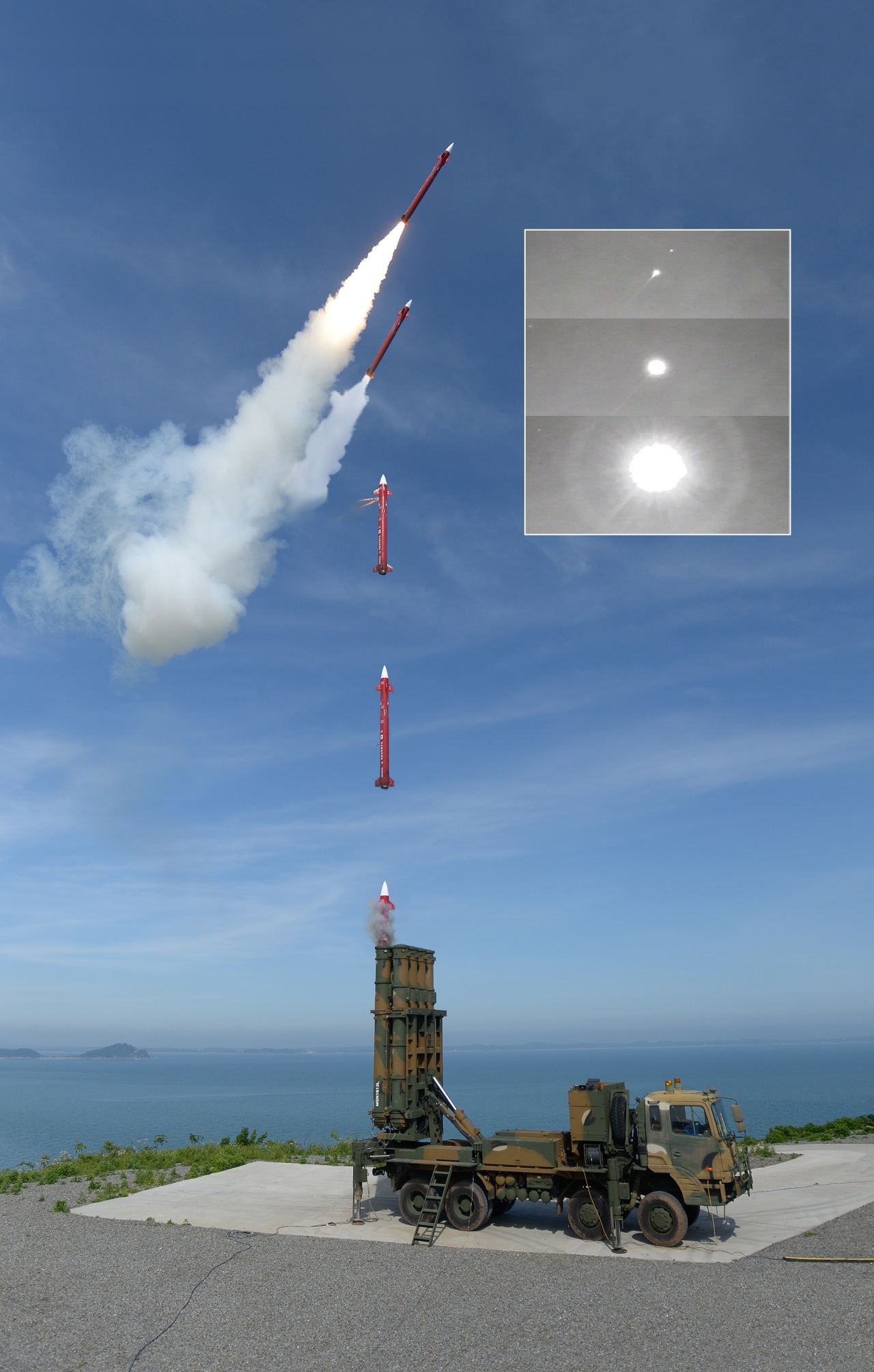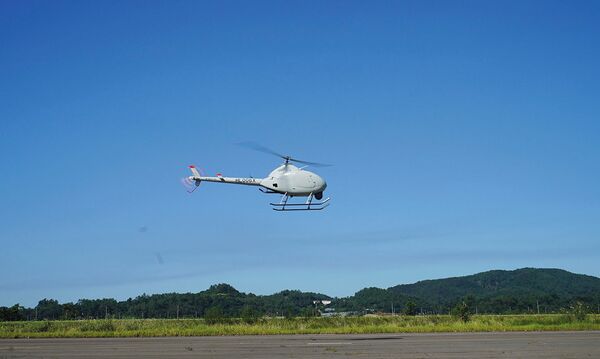Plan to launch interceptor missiles from Korean fighter jets in the rising phase of North Korean missiles, and to develop laser interceptor weapons in phase 2
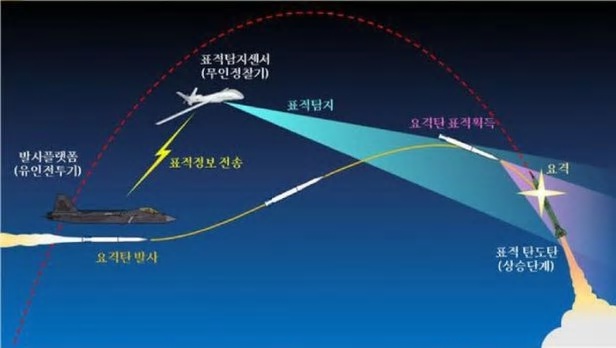
A conceptual diagram of intercepting with a high-speed missile (interceptor) launched from a KF-X (Korean type fighter) in the ascent stage immediately after the North Korean ballistic missile launch. When an unmanned reconnaissance aircraft provides North Korean missile launch information to a Korean fighter, it immediately fires an interceptor and intercepts the North Korean missile. /Provided by Defense Science Research Institute
It is known that military authorities are developing a weapon that intercepts with high-speed missiles (interceptors) launched by KF-X (Korean fighter jets), etc., in the rising phase immediately after launching North Korean ballistic missiles in case of emergency. Intercepting during the missile elevation phase can cause damage to the missile fragments falling onto North Korea's land, thereby deterring North Korea's actual missile launch.
In particular, it is analyzed that it is possible to intercept new missiles such as the North Korean version of Iskander, which are difficult to intercept, or even super-large missiles. The military authorities plan to promote joint development with the United States, and in the mid to long term, develop a system to intercept North Korean missiles in the upward phase with aircraft-mounted laser weapons.
◇ Development in line with the development of Korean-style fighter jets, and joint development with the US
Currently, our military's missile defenses are the Patriot PAC-3 missile and the Chungoong 2 improved missile, which are intercepted at the last stage before the North missile hits our land. It is very short, so there is a possibility of failure. Until now, intercepting during the missile ascent phase has been discussed as the most effective method, but it has not been realized due to technical difficulties.

High-speed interceptor (missile) for intercepting North Korean missiles in the ascending stage being developed by the Defense Science Research Institute. It is mounted and launched on the KF-X (Korean type fighter). /Provided by Defense Science Research Institute
A military source said on the 19th that "the Defense Science Research Institute (ADD) is developing a North Korean missile interceptor that is launched from KF-X," and that "the joint development with the United States is also being promoted." This interceptor weapon was fired from the KF-X immediately after the North Ballistic Missile was launched, and intercepted during the ascent phase. The KF-X is expected to be developed by 2026, and accordingly, it is planning to develop an interceptor missile to be installed on the KF-X by the end of the 2020s.
The military authorities plan to develop a missile-type interceptor, and then develop a laser weapon equipped with a fighter or unmanned aerial vehicle in the medium to long term, and intercept with a laser. Military authorities are also pursuing joint development between Korea and the United States, especially considering that the United States considers North Korea's ICBM (Intercontinental Ballistic Missile) a serious threat and is spurring the development of up-level interceptor weapons such as lasers. One source said, "Last year, the United States convinced the intention to jointly develop an ascending interceptor weapon, and I know it showed a positive reaction."
◇ Defense Science Research Institute unveils the first ascent-level interceptor missile and concept map
According to the concept map of interception published on the website of the Defense Science Research Institute, the missile is raised by detecting a North Korean ballistic missile launched by a Korean mid-range UAV and sending target information to the KF-X equipped with an interceptor (interceptor missile). It is supposed to intercept at the stage. The Defense Science Research Institute also released a picture of an elongated interceptor on its website.
Ballistic missiles such as ICBM fly in three stages: an ascending stage in which they soar after launch, an intermediate stage in which the propellant is burned and flying outside the atmosphere, and an end stage in which it re-enters the atmosphere and falls toward the target. Experts have pointed out that the boost-phase intercept (BPI) is the most effective countermeasure against North Korea's ICBM or mid-range ballistic missiles.
The US Missile Defense Agency (DMA) said, “The ideal strategy for intercepting ballistic missiles is the upward stage.” “At this stage, countermeasures are not mobilized and the missile warhead cannot achieve the speed required to recognize the target.” .
◇ The US is developing an ascending interceptor system after detecting North Korean missiles with unmanned aerial vehicles
'Proceedings', a military magazine published by the US Naval Research Institute (USNI), also said in 2017, "The rising ballistic missile is a single large target with a clear trajectory and does not employ countermeasures, so it is much easier to detect and intercept than in the intermediate and end stages." Said. Prosedings emphasized that "a small interceptor suitable for BPI has sufficient competitiveness in terms of cost."
Arthur Herman, a senior researcher at the Hudson Institute in the United States, said in an article in the Wall Street Journal in March 2017, “BPI has launched an unmanned aerial vehicle equipped with an interceptor missile and advanced infrared detection device at a point of 350 miles (560 km) outside North Korea, about 17 km above the North. It will be operated in a way that monitors security.” The interceptor missile has a warhead weight of 225 kg and is said to have enough power to destroy the ICBM.
In fact, in June 2016, in the first three-country missile warning drill conducted in the waters near Hawaii, the US equipped two medium-sized unmanned aerial vehicles readers' with advanced infrared detection devices to detect ballistic missiles launched from the ground. Had been successful. The United States is developing a system that detects the launch of a North Korean missile with a drone that can stay in the sky for a long time, then fires a missile or laser immediately, and intercepts the North Korean missile in the ascending phase.
◇ Limitations of end-stage interceptors such as Patriot and THAAD
The U.S. had previously developed an ABL (Air Launched Laser) that fires a powerful laser beam from a Boeing 747 (aka jumbo) and intercepts an ascending North Korean missile from hundreds of kilometers away, but stopped in 2011. This is because there was a problem with the safety and performance of the chemical laser (COIL), which is an interceptor.
Although the ascendant intercept is the most ideal, the reason for the delay in development is that the flight time of the ascending phase of the missile is only 1-5 minutes, and the time from detection to intercept is too short. Accordingly, intermediate and end-stage interceptor weapons were intensively developed and deployed. The GMD deployed by the U.S. in Alaska and California and the SM-3 missile deployed on the Aegis ship are representative intermediate-stage interceptors. However, intermediate interception has a limitation in that it is difficult to distinguish between a real warhead and a fake warhead, and it is far from effective.
The end-stage interceptor weapons include THAAD and Patriot PAC-3, which were also deployed in the USFK. Even if the intercept is successful, fragments can fall into the friendly area, and the intercept time is too short, so there is a risk of failure.
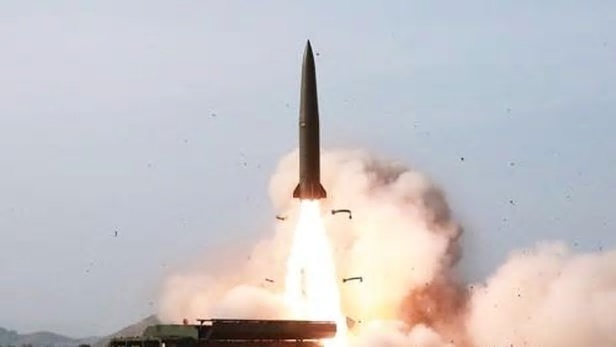
The North Korean version of the Iskander missile that is difficult to intercept with the existing Korean-US missile defense networks. There are many advantages to intercepting North Korean new missiles and super-sized missiles at the rising stage. /Chosun Central TV
◇ There are many advantages in intercepting the ascendant stage, such as the North Korean version of the Iskander missile.
Currently, as the end-stage interceptor, the ROK-US forces have the Patriot PAC-3 CRI (maximum intercepting altitude 15-20 km), and the USFK has the latest Patriot PAC-3 MSE (maximum intercepting altitude 40 km). . From the end of this year, the ROK military is planning to introduce several batteries by 2022, the Cheongung 2 (intercepting altitude 15-20 km), a domestic interceptor missile similar to the Patriot PAC-3. The USFK also deployed a single THAAD (high-altitude missile defense system) battery with a maximum intercepting altitude of 150 km in Seongju, Gyeongbuk.
North Korea's new North Korean version of Iskander and Ataekims (tactical ground-to-ground missile) missiles, and super-sized missiles have a maximum flight altitude of only 30-50 km, making it virtually impossible to intercept with the USFK THAAD system (intercepting altitude 40-150 km). In addition, it has been pointed out that interception is not easy even with the existing Patriot PAC-3 CRI or Chungoong 2 missile. However, successful intercepts in the missile up-level can alleviate these concerns.
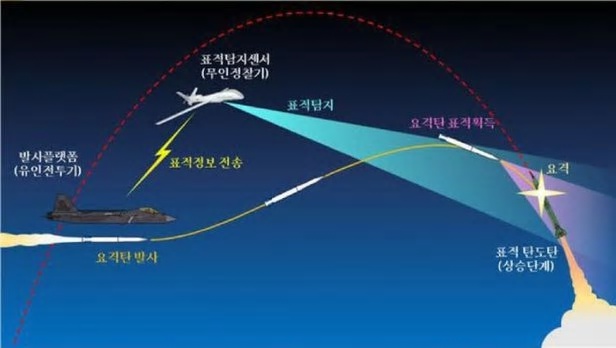

A conceptual diagram of intercepting with a high-speed missile (interceptor) launched from a KF-X (Korean type fighter) in the ascent stage immediately after the North Korean ballistic missile launch. When an unmanned reconnaissance aircraft provides North Korean missile launch information to a Korean fighter, it immediately fires an interceptor and intercepts the North Korean missile. /Provided by Defense Science Research Institute
It is known that military authorities are developing a weapon that intercepts with high-speed missiles (interceptors) launched by KF-X (Korean fighter jets), etc., in the rising phase immediately after launching North Korean ballistic missiles in case of emergency. Intercepting during the missile elevation phase can cause damage to the missile fragments falling onto North Korea's land, thereby deterring North Korea's actual missile launch.
In particular, it is analyzed that it is possible to intercept new missiles such as the North Korean version of Iskander, which are difficult to intercept, or even super-large missiles. The military authorities plan to promote joint development with the United States, and in the mid to long term, develop a system to intercept North Korean missiles in the upward phase with aircraft-mounted laser weapons.
◇ Development in line with the development of Korean-style fighter jets, and joint development with the US
Currently, our military's missile defenses are the Patriot PAC-3 missile and the Chungoong 2 improved missile, which are intercepted at the last stage before the North missile hits our land. It is very short, so there is a possibility of failure. Until now, intercepting during the missile ascent phase has been discussed as the most effective method, but it has not been realized due to technical difficulties.

High-speed interceptor (missile) for intercepting North Korean missiles in the ascending stage being developed by the Defense Science Research Institute. It is mounted and launched on the KF-X (Korean type fighter). /Provided by Defense Science Research Institute
A military source said on the 19th that "the Defense Science Research Institute (ADD) is developing a North Korean missile interceptor that is launched from KF-X," and that "the joint development with the United States is also being promoted." This interceptor weapon was fired from the KF-X immediately after the North Ballistic Missile was launched, and intercepted during the ascent phase. The KF-X is expected to be developed by 2026, and accordingly, it is planning to develop an interceptor missile to be installed on the KF-X by the end of the 2020s.
The military authorities plan to develop a missile-type interceptor, and then develop a laser weapon equipped with a fighter or unmanned aerial vehicle in the medium to long term, and intercept with a laser. Military authorities are also pursuing joint development between Korea and the United States, especially considering that the United States considers North Korea's ICBM (Intercontinental Ballistic Missile) a serious threat and is spurring the development of up-level interceptor weapons such as lasers. One source said, "Last year, the United States convinced the intention to jointly develop an ascending interceptor weapon, and I know it showed a positive reaction."
◇ Defense Science Research Institute unveils the first ascent-level interceptor missile and concept map
According to the concept map of interception published on the website of the Defense Science Research Institute, the missile is raised by detecting a North Korean ballistic missile launched by a Korean mid-range UAV and sending target information to the KF-X equipped with an interceptor (interceptor missile). It is supposed to intercept at the stage. The Defense Science Research Institute also released a picture of an elongated interceptor on its website.
Ballistic missiles such as ICBM fly in three stages: an ascending stage in which they soar after launch, an intermediate stage in which the propellant is burned and flying outside the atmosphere, and an end stage in which it re-enters the atmosphere and falls toward the target. Experts have pointed out that the boost-phase intercept (BPI) is the most effective countermeasure against North Korea's ICBM or mid-range ballistic missiles.
The US Missile Defense Agency (DMA) said, “The ideal strategy for intercepting ballistic missiles is the upward stage.” “At this stage, countermeasures are not mobilized and the missile warhead cannot achieve the speed required to recognize the target.” .
◇ The US is developing an ascending interceptor system after detecting North Korean missiles with unmanned aerial vehicles
'Proceedings', a military magazine published by the US Naval Research Institute (USNI), also said in 2017, "The rising ballistic missile is a single large target with a clear trajectory and does not employ countermeasures, so it is much easier to detect and intercept than in the intermediate and end stages." Said. Prosedings emphasized that "a small interceptor suitable for BPI has sufficient competitiveness in terms of cost."
Arthur Herman, a senior researcher at the Hudson Institute in the United States, said in an article in the Wall Street Journal in March 2017, “BPI has launched an unmanned aerial vehicle equipped with an interceptor missile and advanced infrared detection device at a point of 350 miles (560 km) outside North Korea, about 17 km above the North. It will be operated in a way that monitors security.” The interceptor missile has a warhead weight of 225 kg and is said to have enough power to destroy the ICBM.
In fact, in June 2016, in the first three-country missile warning drill conducted in the waters near Hawaii, the US equipped two medium-sized unmanned aerial vehicles readers' with advanced infrared detection devices to detect ballistic missiles launched from the ground. Had been successful. The United States is developing a system that detects the launch of a North Korean missile with a drone that can stay in the sky for a long time, then fires a missile or laser immediately, and intercepts the North Korean missile in the ascending phase.
◇ Limitations of end-stage interceptors such as Patriot and THAAD
The U.S. had previously developed an ABL (Air Launched Laser) that fires a powerful laser beam from a Boeing 747 (aka jumbo) and intercepts an ascending North Korean missile from hundreds of kilometers away, but stopped in 2011. This is because there was a problem with the safety and performance of the chemical laser (COIL), which is an interceptor.
Although the ascendant intercept is the most ideal, the reason for the delay in development is that the flight time of the ascending phase of the missile is only 1-5 minutes, and the time from detection to intercept is too short. Accordingly, intermediate and end-stage interceptor weapons were intensively developed and deployed. The GMD deployed by the U.S. in Alaska and California and the SM-3 missile deployed on the Aegis ship are representative intermediate-stage interceptors. However, intermediate interception has a limitation in that it is difficult to distinguish between a real warhead and a fake warhead, and it is far from effective.
The end-stage interceptor weapons include THAAD and Patriot PAC-3, which were also deployed in the USFK. Even if the intercept is successful, fragments can fall into the friendly area, and the intercept time is too short, so there is a risk of failure.

The North Korean version of the Iskander missile that is difficult to intercept with the existing Korean-US missile defense networks. There are many advantages to intercepting North Korean new missiles and super-sized missiles at the rising stage. /Chosun Central TV
◇ There are many advantages in intercepting the ascendant stage, such as the North Korean version of the Iskander missile.
Currently, as the end-stage interceptor, the ROK-US forces have the Patriot PAC-3 CRI (maximum intercepting altitude 15-20 km), and the USFK has the latest Patriot PAC-3 MSE (maximum intercepting altitude 40 km). . From the end of this year, the ROK military is planning to introduce several batteries by 2022, the Cheongung 2 (intercepting altitude 15-20 km), a domestic interceptor missile similar to the Patriot PAC-3. The USFK also deployed a single THAAD (high-altitude missile defense system) battery with a maximum intercepting altitude of 150 km in Seongju, Gyeongbuk.
North Korea's new North Korean version of Iskander and Ataekims (tactical ground-to-ground missile) missiles, and super-sized missiles have a maximum flight altitude of only 30-50 km, making it virtually impossible to intercept with the USFK THAAD system (intercepting altitude 40-150 km). In addition, it has been pointed out that interception is not easy even with the existing Patriot PAC-3 CRI or Chungoong 2 missile. However, successful intercepts in the missile up-level can alleviate these concerns.

<밀톡><단독> 북 미사일 발사 직후 요격무기 개발한다!
[밀톡] 북 미사일 솟구치면 바로 ‘쾅’… 군, 요격 무기 개발한다 [단독]북 미사일 상승단계서 한국형 전투기서 요격 미사일 발사, 2단계 레이......
bemil.chosun.com






